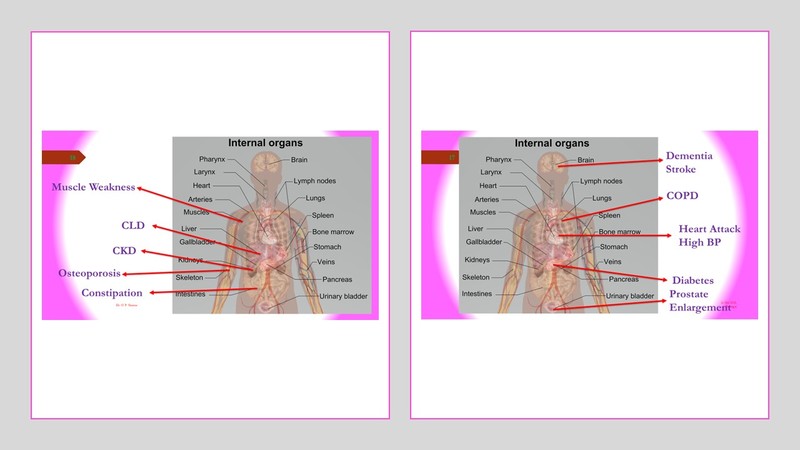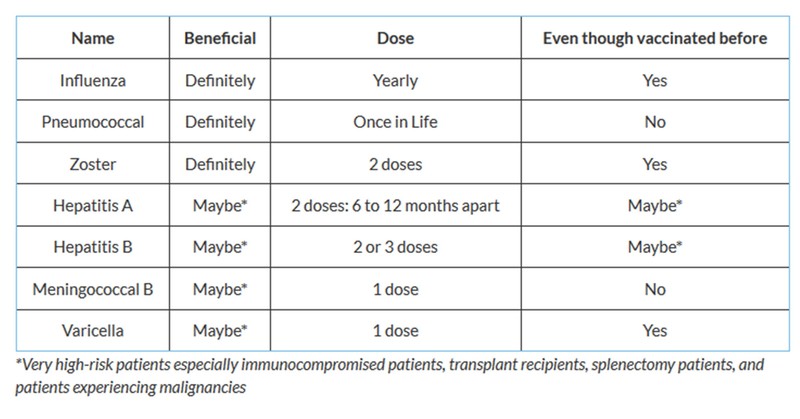Infections in the elderly- Can we do something?: Dr. OP Sharma
M3 India Newsdesk Jun 03, 2020
The elderly are more susceptible to infection, which is attributed to a less capable immune response to infectious agents. Multiple determinants, such as diseases, conditions, or exposure affect the risk of infection in them by contributing to declining immune function. Here, Dr. OP Sharma discusses factors responsible for infections and the various immune boosters- pharmacological and non-pharmacological interventions to help improve the immune system in the elderly.

Rising segment of population- Indian context
A longer life may be a boon but has its challenges for older people, their families, societies, nation and the world as whole. Global ageing has not been uniform in different countries. Genetic and environmental factors have been playing their roles.
India also recorded increase in life expectancy at birth, from 47 years in 1949, to 60 years in 1994 and 69 years in 2019. As per Population Census 2011, there are nearly 104 million elderly persons in India of which approximately 73 million reside in rural areas and 31 million in urban areas. The number of elderly women has been steadily overtaking men. By the year 2030,12.5% of India’s population is expected to be above 60 years and older.
Physiological changes
There are unfavourable results due to ageing- changes in defence mechanism, at the level of various organs, as given in Table 1 and the diseases caused by them as given in Table 2.
Table 1 - Physiological changes and its effects
| Organ | Age related change in defence mechanism | Result |
| Kidney |
Inability to maintain osmolality, pH; and concentration of organic acid, urea and Tam-Horsfall protein |
Bacterial colonisation, bacteriuria and urinary tract infection |
| Ureters | Inadequate peristalsis and incompetent vesico-ureteric valve | Reflux, ascending infection |
| Bladder | Impaired emptying capacity and defective surface mucin | Reflux, ascending infection |
| Lungs | Reduced expiratory flow rate and vital capacity; increased residual volume and infective | Diminished clearance of infection alveolar macrophage function |
| Bronchi | Sluggish mucociliary transport | Diminished clearance of infection |
| Pharynx | Abnormal swallowing mechanism and impaired cough reflux | Aspiration |
| GI Tract | Loss of gastric acidity | Bacterial overgrowth |
| Skin | Breach in skin integrity due to epidermal and dermal atrophy and decrease in number and function of Langerhans cells | Increased infection |
Table 2 - Changes due to ageing and diseases

Comorbidities
As age advances, one or more diseases may occur in the elderly and increase the morbidity status. These comorbidities are type 2 diabetes, heart failure, chronic obstructive pulmonary disease, chronic kidney disease, chronic liver disease, and cancers. Lately, stress is also being laid down as a factor and so are sleep problems like OSA and consequently nocturnal aspirations. The side effects of drugs like steroids used for these diseases also add fuel to fire.
Immunosenescence
The human immune system undergoes significant changes especially after the sixth decade of life due to uncontrolled comorbidities. The ageing immune system loses the ability to protect the susceptible individual against infections, cancer, with an inability to maintain homeostasis and an immune response as well as surveillance.
Immune ageing or immunosenescence is closely related to organismal ageing. Immunosenescence affects both the innate and adaptive immunity. Among these, it is primarily the adaptive immunity and the T-cell subset which is most susceptible to the deleterious changes especially with the involution of the thymus gland by midlife. Hormonal influences from endocrine disorders with increased incidence in the elderly such as diabetes, hypothyroidism and adrenal dysfunction are associated with increased susceptibility to infection.
There is a reduction in synthesis of T and B lymphocytes and there is reduced capacity of these cells to mount a specific immune response. The risk of infection increases in persons with impaired IgG synthesis, impaired phagocytosis and defective clearance of secretions.
Oxidative stress is believed to be a major factor of accelerated ageing, possibly due to an increased pace of telomere shortening resulting from DNA damage. Telomeres are DNA+protein complexes at the end of chromosomes and are supposed to be the molecular clock of ageing, including that of the immune system, especially lymphocytes. Age-related deficits in innate immune functions might therefore alter both cell-mediated and humoral adaptive immune reactions.
Innate immunity is a key element of the immune response including several cellular components such as macrophages, NK cells,and neutrophils, which provide rapid first-line defence against pathogens. The functions of these cells decline with age. In the elderly macrophages have a reduced ability to secrete tumour necrosis factor (TNF), a key inflammatory cytokine. Macrophage-derived TNF and interleukin (IL)-1 are essential for the secretion of other cytokines critical for bone marrow stromal integrity, such as IL-6, IL-11, monocyte colony stimulating factor (M-CSF), granulocyte-monocyte (GM)-CSF and receptor activators of NF-kB ligand. Ageing also dampens the secretion of IL-7 by bone marrow stromal cells. IL-7 is an essential survival cytokine for developing lymphocytes. Both the chemotactic and phagocytic activities of neutrophils show reduced efficacy with ageing. NK cells account for about 10-20% of peripheral blood lymphocytes. Most mature NK cells (approximately 90%) express high levels of CD16 and CD56.The NK cell function and dynamics may be affected by ageing. The decline of NK cells may offer an explanation for the increased incidence of bacterial and viral pneumonia, as well as gastrointestinal and skin infections in old age.
Haematopoietic system cells (HSCs) give rise to all cellular components of the immune system (lymphoid and myeloid). The reservoir of naïve B cells might be one of the factors that make centenarian off-springs able to keep fighting off new infections, hence prolonging their life. The loss of naïve B cells represents a hallmark of immunosenescence. The quality of the humoral immune response declines with age. There is a decrease in the diversity and functional integrity of both the CD4+ and CD8+ T-cell subsets, which contributes to a decreased ability to respond adequately to re-infection.
Aged individuals (>65 years) have an increase in peripheral blood Treg cells, but the lack of IL-7 receptor (CD127) expression on the surface of these cells results in their functional damage. Treg lymphocytes downregulate the immune response after elimination of an antigen, control the host immune response to prevent damages to host tissues, and protect the host from self-reactive lymphocytes by deleting autoreactive immunocompetent cells.
Remedies
Immune boosters help the immune system in elderly to bring them at par with adults, in their fight against infections. Lifestyle modifications that are generally associated with a good immune response are a nutritious diet with adequate proteins and vegetables, adequate sleep, avoiding smoking and excessive alcohol consumption, exercising regularly, and practising other stress-relieving methods.
Nonpharmacological
Lifestyle measures: The elderly need to practice the following:
- Programmed walking at home.
- Nutritious diet with adequate calories; a balance of proteins, carbohydrates, fats, water, minerals and vitamins.
- Yoga and meditation (based upon physical condition and diseases).
- Sleep hygiene which consists of-
- Regular sleep time and awakening
- No coffee/tea near sleep times
- Going to bed at least 2 hours after dinner
- Listening to light music
- Limiting blue light exposure near bedtime
- Improved oral hygiene.
- Improved respiratory hygiene which includes exercises/yoga for upper respiratory as well as lower respiratory tracts.
- Spending time with their children and grandchildren.
Pharmacological
- Management of all comorbid conditions. The longer stay in hospitals is because of the combination of existing uncontrolled comorbidities along with the presenting diseases.
- Detection and treat SDB-OSA. Insomnia may require hypnotic medication.
- Use of certain immunity boosters which are known to act by improving mucociliary clearance, neutrophilic chemotaxis, phagocytosis, B and T cell maturation, production of cytokines, and other agents which may enhance innate immune response.
- Certain vitamins and minerals, including vitamin C, D, E, B6, zinc, selenium, magnesium are used in conjunction with treatments for boosting of immune response
- Pre- and pro-biotics in the gut microflora are known to boost immunity
- Pterostilbene and resveratrol found in blueberries and red grapes help rise the expression of human cathelicidin antimicrobial peptide (CAMP) gene which is involved in innate immunity
- DHA from fish has been found to enhance B cell activity
- Curcumin extract from turmeric may assist the immune system
- Sunlight and specifically blue light found in sun rays make T cells move faster to a site of infection and may help in some superficial infections
- Vaccines as given in Table 3, are a known therapeutic intervention to boost immune responses
Table 3- Vaccination in the elderly
Disclaimer- The views and opinions expressed in this article are those of the author's and do not necessarily reflect the official policy or position of M3 India.
The author Dr. O. P. Sharma is a Senior Consultant Geriatric Medicine at Indraprastha Apollo Hospitals, New Delhi
-
Exclusive Write-ups & Webinars by KOLs
-
Daily Quiz by specialty
-
Paid Market Research Surveys
-
Case discussions, News & Journals' summaries